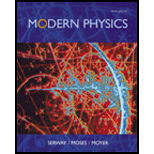
Modern Physics
3rd Edition
ISBN: 9781111794378
Author: Raymond A. Serway, Clement J. Moses, Curt A. Moyer
Publisher: Cengage Learning
expand_more
expand_more
format_list_bulleted
Question
Chapter 11, Problem 4Q
To determine
The mechanism responsible for the different types of bonds that can occur to form stable molecules.
Expert Solution & Answer
Want to see the full answer?
Check out a sample textbook solution
Students have asked these similar questions
In this problem you will model the mixing energy of a mixture in a relatively simple way, in order to relate the existence of a solubility gap to molecular behavior. Consider a mixture of A and B molecules that is ideal in every way but one: The potential energy due to the interaction of neighboring molecules depends upon whether the molecules are like or unlike. Let n be the average number of nearest neighbors of any given molecule (perhaps 6 or 8 or 10). Let Uo be the average potential energy associated with the interaction between neighboring molecules that are the same (A-A or B-B), and let UAB be the potential energy associated with the interaction of a neighboring unlike pair (A-B). There are no interactions beyond the range of the nearest neighbors; the values of Uo and UAB are independent of the amounts of A and B; and the entropy of mixing is the same as for an ideal solution.
Show that when the system is unmixed, the total potential energy due to all neighbor-neighbor…
In this problem you will model the mixing energy of a mixture in a relatively simple way, in order to relate the existence of a solubility gap to molecular behavior. Consider a mixture of A and B molecules that is ideal in every way but one: The potential energy due to the interaction of neighboring molecules depends upon whether the molecules are like or unlike. Let n be the average number of nearest neighbors of any given molecule (perhaps 6 or 8 or 10). Let Uo be the average potential energy associated with the interaction between neighboring molecules that are the same (A-A or B-B), and let UAB be the potential energy associated with the interaction of a neighboring unlike pair (A-B). There are no interactions beyond the range of the nearest neighbors; the values of Uo and UAB are independent of the amounts of A and B; and the entropy of mixing is the same as for an ideal solution.
Find a formula for the total potential energy when the system is mixed, in terms of x, the fraction…
The internuclear distance (bond length) of carbon monoxide molecule is 1.13 Å. Calculate the energy (in joules and eV) of this molecule in the first excited rotational level. Also calculate the angular velocity of the molecule. Given atomic masses of 12^C = 1.99x10^-26 kg; 16^O = 2.66x10^-26 kg.
Chapter 11 Solutions
Modern Physics
Ch. 11.2 - Compare the effective force constant for the CO...Ch. 11 - Prob. 1QCh. 11 - Prob. 2QCh. 11 - Prob. 3QCh. 11 - Prob. 4QCh. 11 - Prob. 5QCh. 11 - Prob. 7QCh. 11 - Prob. 8QCh. 11 - Prob. 9QCh. 11 - Prob. 1P
Ch. 11 - Use the data in Table 11.2 to calculate the...Ch. 11 - The CO molecule undergoes a rotational transition...Ch. 11 - Prob. 4PCh. 11 - Prob. 5PCh. 11 - Prob. 6PCh. 11 - Prob. 7PCh. 11 - The v = 0 to v = 1 vibrational transition of the...Ch. 11 - Consider the HCl molecule, which consists of a...Ch. 11 - Prob. 10PCh. 11 - Prob. 11PCh. 11 - Prob. 12PCh. 11 - Prob. 13PCh. 11 - Prob. 14PCh. 11 - Prob. 15PCh. 11 - Prob. 18P
Knowledge Booster
Learn more about
Need a deep-dive on the concept behind this application? Look no further. Learn more about this topic, physics and related others by exploring similar questions and additional content below.Similar questions
- The CO molecule undergoes a rotational transition from the ℓ = 1 level to the ℓ = 2 level. Using Table 11.1, calculate the values of the reduced mass and the bond length of the molecule. Compare your results with those of Example 11.1.arrow_forwardUse the data in Table 11.2 to calculate the reduced mass of the NO molecule; then compute a value for using Equation 11.3. Compare the two results.arrow_forwardIf an electron is removed from each molecule, it is observed that N2+ has a weaker bond than N2, but O2+ has a stronger bond than O2. Explain why electron removal has a different effect on these two molecules.arrow_forward
arrow_back_ios
arrow_forward_ios
Recommended textbooks for you
 Modern PhysicsPhysicsISBN:9781111794378Author:Raymond A. Serway, Clement J. Moses, Curt A. MoyerPublisher:Cengage Learning
Modern PhysicsPhysicsISBN:9781111794378Author:Raymond A. Serway, Clement J. Moses, Curt A. MoyerPublisher:Cengage Learning An Introduction to Physical SciencePhysicsISBN:9781305079137Author:James Shipman, Jerry D. Wilson, Charles A. Higgins, Omar TorresPublisher:Cengage Learning
An Introduction to Physical SciencePhysicsISBN:9781305079137Author:James Shipman, Jerry D. Wilson, Charles A. Higgins, Omar TorresPublisher:Cengage Learning

Modern Physics
Physics
ISBN:9781111794378
Author:Raymond A. Serway, Clement J. Moses, Curt A. Moyer
Publisher:Cengage Learning

An Introduction to Physical Science
Physics
ISBN:9781305079137
Author:James Shipman, Jerry D. Wilson, Charles A. Higgins, Omar Torres
Publisher:Cengage Learning

The Laws of Thermodynamics, Entropy, and Gibbs Free Energy; Author: Professor Dave Explains;https://www.youtube.com/watch?v=8N1BxHgsoOw;License: Standard YouTube License, CC-BY